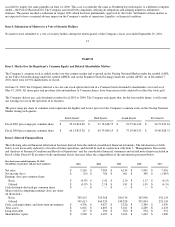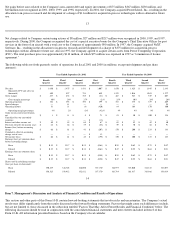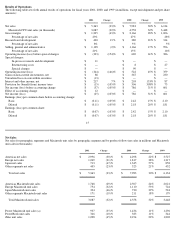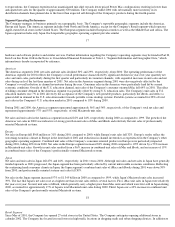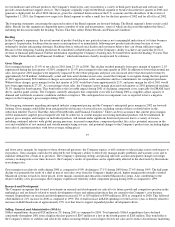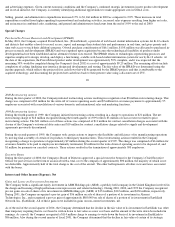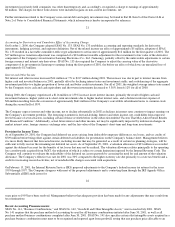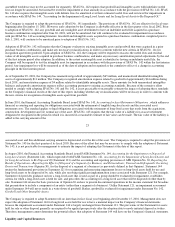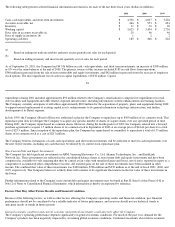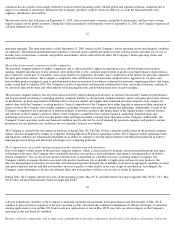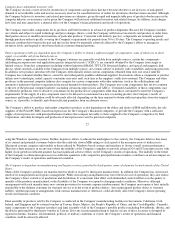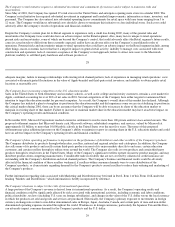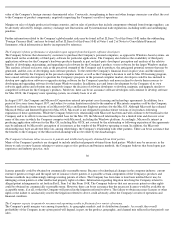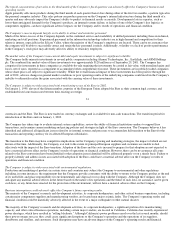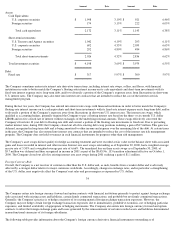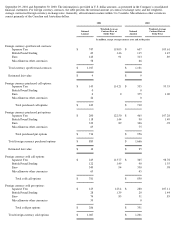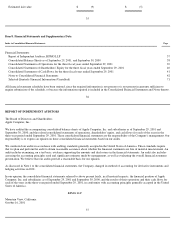Apple 2001 Annual Report Download - page 21
Download and view the complete annual report
Please find page 21 of the 2001 Apple annual report below. You can navigate through the pages in the report by either clicking on the pages listed below, or by using the keyword search tool below to find specific information within the annual report.
conditions has also made it increasingly difficult to forecast future operating results. Should global and regional economic conditions fail to
improve or continue to deteriorate, demand for the Company's products could be adversely affected, as could the financial health of its
suppliers, distributors, and resellers.
The terrorist attacks that took place on September 11, 2001, have created many economic and political uncertainties and have had a strong
negative impact on the global economy. During the weeks immediately following the events of September 11, 2001, the Company experienced
a drop in demand across all of its
25
operating segments. The long-term effects of the September 11, 2001 attacks on the Company's future operating results and financial condition
are unknown. The national and international responses to terrorist attacks and the potential for future terrorist attacks and other acts of war or
hostility have created many economic and political uncertainties which could adversely affect the Company's future operating results and
financial condition.
The market for personnel computers is highly competitive.
The personal computer industry is highly competitive and is characterized by aggressive pricing practices, downward pressure on gross
margins, frequent introduction of new products, short product life cycles, continual improvement in product price/performance characteristics,
price sensitivity on the part of consumers, and a large number of competitors. Recently, price competition in the market for personal computers
has been particularly intense. The Company's competitors who sell Windows-based personal computers have aggressively cut prices and
lowered their product margins to gain or maintain market share in response to weakness in demand for personal computing products that began
in the second half of calendar 2000. The Company's results of operations and financial condition have been, and in the future may continue to
be, adversely affected by these and other industry wide pricing pressures and downward pressures on gross margins.
The personal computer industry has also been characterized by rapid technological advances in software functionality, hardware performance,
and features based on existing or emerging industry standards. Further, as the personal computer industry and its customers place more reliance
on the Internet, an increasing number of Internet devices that are smaller and simpler than traditional personal computers may compete for
market share with the Company's existing products. Several competitors of the Company have either targeted or announced their intention to
target certain of the Company's key market segments, including consumer, education, and design and publishing. Additionally, several of the
Company's competitors have introduced or announced plans to introduce products that mimic many of the unique design, technical features,
and solutions of the Company's products. Many of the Company's competitors have greater financial, marketing, manufacturing, and
technological resources, as well as broader product lines and larger installed customer bases than those of the Company. Additionally, the
Company's future operating results and financial condition may be affected by overall demand for personal computers and general customer
preferences for one platform over another or one set of product features over another.
The Company is currently the only maker of hardware using the Mac OS. The Mac OS has a minority market share in the personal computer
market, which is dominated by makers of computers utilizing Microsoft Windows operating systems. The Company's future operating results
and financial condition are substantially dependent on its ability to continue to develop improvements to the Macintosh platform in order to
maintain perceived design and functional advantages over competing platforms.
The Company must successfully manage frequent product introductions and transitions.
Due to the highly volatile nature of the personal computer industry, which is characterized by dynamic customer demand patterns and rapid
technological advances, the Company must continually introduce new products and technologies and enhance existing products in order to
remain competitive. The success of new product introductions is dependent on a number of factors, including market acceptance, the
Company's ability to manage the risks associated with product transitions, the availability of application software for new products, the
effective management of inventory levels in line with anticipated product demand, the availability of products in appropriate quantities to meet
anticipated demand, and the risk that new products may have quality or other defects in the early stages of introduction. Accordingly, the
Company cannot determine in advance the ultimate effect that new products will have on its sales or results of operations.
During 2001, the Company introduced a new client operating system, Mac OS X, and delivered its first major upgrade, Mac OS X v.10.1. Mac
OS X offers advanced functionality based on Apple and NeXT
26
software technologies. Inability of the Company to maintain continued advancements in the performance and functionality of Mac OS X,
continue to gain customer acceptance of the new operating system, and obtain the continued commitment of software developers to transition
existing applications to run on Mac OS X and create new applications to run on Mac OS X, may have an adverse impact on the Company's
operating results and financial condition.
Because orders for components, and in some cases commitments to purchase components, must be placed in advance of customer orders, the


